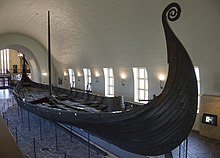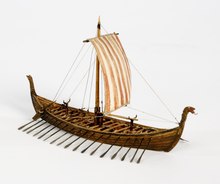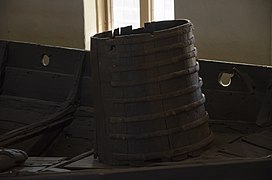Oseberg Ship



The Oseberg ship (Norwegian: Osebergskipet) is a well-preserved
Excavation of the ship from the Oseberg burial mound (Norwegian: Oseberghaugen ved Slagen from the Old Norse word haugr meaning kurgan mound or barrow) was undertaken by Swedish archaeologist Gabriel Gustafson and Norwegian archaeologist Haakon Shetelig in 1904–1905.[2] The grave also contained two female human skeletons as well as a considerable number of grave goods. Scientific dating of the ship suggests it was buried no earlier than 834, although certain parts of its structure date from as early as 800, while other parts may be even older.[1]
Structure
The ship is a
During the debate on whether to move the original ship to a proposed new museum, thorough investigations were made into the feasibility of moving the ship without damaging it. As part of that process, highly detailed photographic and laser scans of both the exterior and interior of the ship were made.[4]
Replica
In 2004, an attempt to build a copy of the Oseberg ship was launched. A collective effort of Norwegian and Danish professional builders, scientists and volunteers engaged in this new attempt with the photo and laser scans made available free of charge to the builders. During this new attempt, it was discovered that during the initial restoration of the ship a breach in some of the beams had been made and that the ship was therefore inadvertently altered, a fact that had not been appreciated earlier. This may be why an earlier replica, the 'Dronningen', sank; this previous attempt had failed owing to a lack of this knowledge.[5][6][further explanation needed]
In 2010, a new reconstruction project called Saga Oseberg was started. Using timber from Denmark and Norway and utilizing traditional building methods from the Viking Age, this newest Oseberg ship was successfully completed. The new ship was launched from the city of Tønsberg on 20 June 2012. The ship floated very well and in March 2014 it was sailed on the open seas, with Færder as its destination; the ship performed very well, achieving a speed of 10 knots under full sail. The reconstruction was thus a success and demonstrated that the Oseberg ship really could have sailed and was not just a burial chamber on land.[7]
Human remains

The
According to
Examinations of fragments of the skeletons have provided more insight into their lives. The younger woman's teeth showed signs that she used a metal toothpick, a rare 9th century luxury. Both women had a diet composed mainly of meat, another luxury when most Vikings ate fish. However, there was not enough DNA to tell if they were related.[16]
The women were found together in one bed.[17]
Grave goods
The grave had been disturbed in antiquity, and objects made of precious metals were absent. Nevertheless, a great number of everyday items and artifacts were found during the 1904–1905 excavations. These included four elaborately decorated sleighs, a richly carved four-wheel wooden cart, bed-posts, and wooden chests, as well as the so-called "
The conservation of the wooden artifacts is an ongoing problem. On May 3, 2011, thirteen years after debate began over the disposition of the ship, Norwegian Minister of Education Kristin Halvorsen stated that the ship will not be moved from Bygdøy.[19][20]
Gallery
-
The Oseberg ship (Viking Ship Museum, Norway).
-
Excavation of the Oseberg ship, 1904/5.
-
Moving the ship on rails to its current location at Bygdøy, September 1926.
-
Barrel in the Oseberg ship.
-
Part of the rudder, or "steering board" (hence the term "starboard") of the ship.
Film
- Outlander (2008): a ship in the movie is based on the Oseberg ship
- Ragnarok (2013): secrets behind Ragnarok are discovered using the artifacts found in the Oseberg Ship
See also
- Norway
- Gokstad ship, Vestfold
- Tune ship, Østfold
- Gjellestad ship
- England
- Snape Anglo-Saxon Cemetery, Suffolk
- Sutton Hoo, Suffolk
- Denmark
References
- ^ a b Durham (2002:16).
- ^ Durham (2002:15).
- ^ "Karve ships". thevikingships. Retrieved August 15, 2016.
- ^ The Klåstad ship Archived 2015-03-08 at the Wayback Machine Osebergvikingskip
- ^ Gåten Oseberg nrk.no
- ^ Oseberg Viking Ship Facebook
- ^ "Oseberg Viking Skip". Stiftelsen Nytt Osebergskip. Archived from the original on February 10, 2011. Retrieved August 15, 2016.
- ^ "Vikings acquitted in 100-year-old murder mystery | ABS-CBN News". 2021-03-14. Archived from the original on 2021-03-14. Retrieved 2021-03-15.
- .
- ^ Vikingaskeppet Oseberg (Vikingaskeppet Orm)
- ^ Bonde, Niels; Christensen, A.E (1993). 'Dendrochronological dating of the Viking Age ship burials at Oseberg, Gokstad, and Tune, Norway (67 ed.). Antiquity. pp. 575–83 [581].
- ^ Kruger, Sverre (June 9, 2007). "Dronning Åsa av Oseberg – Forskerne har nå avslørt droning Åsa som Oseberghaugens herskerinne". Nrk.no. Retrieved 2010-04-11.
- ISSN 1461-9571.
- ^ Berglund, Nina (Mar 26, 2007). "Viking woman had roots near the Black Sea". Aftenposten.no. Archived from the original on 2010-08-26. Retrieved 2010-04-11.
- ^ plakater[permanent dead link](uio.no)
- . Retrieved 2010-04-11.
- ^ "The excavation of the Oseberg ship - Museum of Cultural History". 2021-03-15. Archived from the original on 2021-03-15. Retrieved 2021-03-15.
- ^ "Borromean Triangles: A Viking Symbol". Liv.ac.uk. 2007-07-27. Retrieved 2010-04-11.
- ^ Kein Geld: Oseberg-Fund verrottet Archaeologik (17.4.2012)
- ^ Forsegler skipenes skjebne klassekampen.no
Works cited
- Christensen, A. E. Ingstad, A. S. and Myhre, B. (1992) "Oseberg Dronningens Grav – Vår Arkeologiske Nasjonalskatt i Nytt Lys", Oslo
- Durham, Keith. ISBN 1-84176-349-7
- Doyle, Alister (Apr 25, 2008). Vikings acquitted in 100-year-old murder mystery. Reuters.
- Hagen, Anders (1968) The Viking Ship Finds: The Oseberg, Gokstad, and Tune Ships (Universitetets Oldsaksamling)
- Shetelig, Haakon; A.W. Brøgger (1950) Vikingeskipene (Oslo: Dreyer)
- Shetelig, Haakon (1928) Queen Asa's Sculptors: Wood Carvings found in the Oseberg Ship, Norway (London: Burlington House)
- Sjovold, Thorleif (1969) The Oseberg Find and the Other Viking Ship Finds Mary Fjeld Sjovold, translation (Universitetets Oldsaksamling)
- Sjovold, Thorleif (1954) The Viking Ships – A Short Description of the Tune, Gorstad and Oseberg Ships (Dreyers Forlag)
External links
- Osebergskipet – The Oseberg Ship
- Oseberg find 100-year anniversary
- Conservation of Gustafson's Sleigh
- Textiles in the Oseberg ship by Anne Stine Ingstad
- Index of Norwegian Viking ships
- New Oseberg Ship Foundation
- Replica Saga Oseberg tacking
- Replica Saga Oseberg wearing
- Replica Saga Oseberg sailing close hauled






